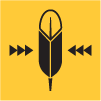Native TikTok
By: Bobbi Ramirez
Tribal affiliation: Navajo
’18 BA Journalism & Mass Communication
In the spring of 2020, I hopped on TikTok like a lot of other people who became bored when businesses started closing down and we were told to stay home. I felt tired of Instagram and all the beautiful yet carefully edited photos: I often caught myself comparing my features and clothing to girls strategically posed, styled and edited. “This is toxic,” I thought. “I’m not even actively trying to compare myself. I know these photos are edited, I know clothing or material items don’t make a person. I know I’m Navajo and that I shouldn’t expect myself to look like influencers.” So I pushed away from Instagram and took down all my personal photos, a move I’ve done two or three times before. Getting off Facebook wasn’t easy because it meant losing contact with people I had known since elementary school and leaving my garden, neighborhood and Navajo groups. I decided to leave because I never felt connected with anyone or understood my culture more, no matter how many groups I joined.
Growing up off the Navajo Nation, I often feel ignorant about my own culture, embarrassed to ask questions. I was raised in border towns like Holbrook and Farmington where style and beauty standards favored non-Native people. Being on Instagram and Facebook, I still felt like a foreigner in my own country because I rarely saw people who looked like me. I logged onto TikTok not really looking for anything or anyone to relate to. I work in digital marketing, so it is important for me to be knowledgeable about upcoming social media platforms and their capabilities. Yet, I found myself shocked after clicking through a few videos by how much TikTok was able to zero-in on not only my interests but parts of me that I wasn’t in touch with anymore, like being Native American. My ‘For You Page’ began to flood with Indigenous content creators young and old from all over the world who shared traditions, prayers, songs, stories, and art. I’ve learned about throat singing, the history of missions, men’s braids, and issues still affecting our people today.
Pride is what I felt watching Indigenous content creators, and it wasn’t hard to find them after I liked a few videos with the tags #Indigenous, #Native, #NativeAmerican and #NativeTikTok. Unlike Instagram and Facebook, these tags were not overrun with the same repeating or irrelevant content. One of the first videos I watched was a 15-second video with dancer/singer Tia Wood (Plains Cree, Salish) @tiamiscihk. In the video, Tia takes a viral video and ‘makes it Indigenous.’ Like many Native TikTok content creators, Tia seems proud and confident to share her traditions in a contemporary way. It wasn’t long before I found TikTokers from tribes all over the world proudly donning their traditional clothing and dance regalia alongside music samples of Rihanna’s “Desperado” or A Tribe Called Red’s “Electric Pow Wow Drum.” It was inspiring to say the least. Short videos of Native strength, beauty and resilience came through my phone repeatedly. I began to feel not only inspired to learn more about my culture but proud of who we are. When I watch TikTok videos with Native creators, I feel optimistic for the future of our people staying connected. Sharing our stories is so important.
Bobbi’s favorite Native TikTok creators
@shinanova | TikTok
Shina Nova is an Inuk throat singer living in Canada. Her videos are a beautiful compilation of traditional songs and displays of her traditional clothing. She says throat singing is a form of healing which she and her mother still proudly practice today.
@kkymonn
Kymon Palau is a Tongan and Diné creator whose videos feature important conversations about issues affecting Indigenous people and their communities. Kymon’s top videos work to dispel Indigenous stereotypes and share cultural knowledge.
@ohkairyn | TikTok
Kairyn is a Nakota Sioux creator whose videos are a mixture of comedic skits and serious conversations that advocate for mental health, Two-Spirit/Indigiqueer rights and cultural awareness. My favorite videos of his are Indigenous parodies of Sex and The City, Aunty Wears Prada, and Rezmas Poem.
@brettstoise | TikTok
Brett Mooswa is a Cree creator living in Loon Lake, Saskatchewan, Canada. His videos are pure Indigenous comedy poking fun at Native stereotypes through short skits.
@geronimo.louie | TikTok
Geronimo Louie is a Two-Spirit Chiricahua Apache and Navajo creator living in Gallup, New Mexico. Featured in Vogue for his style and ribbon work, Geronimo’s TikTok videos show he is also a major advocate for Indigenous rights and cultural knowledge.
@jayhosteen | TikTok
Jay Hosteen is a Navajo husband, father and teacher living in the Tuba City, Arizona, area. If you like light-hearted skits about Nálí’s frybread and life on the Navajo Nation, his videos are for you.
@thatnativebaddiebrandooo |
Brandon is a Navajo Two-Spirit creator living in Tuba City, Arizona. His videos are a mixture of personal stories and experiences including how to dodge rez dogs in Crocs to relationship advice.
@natnative88 | TikTok
Natalie Benally, Navajo, is the voice of Dory from the Navajo-dubbed version of Pixar’s “Finding Nemo.” Natalie shares videos of her dancing, singing and acting. In one video, she talks about Indigenous people’s struggles working in the entertainment industry. Natalie is currently working to build her company Tse’ Nato’, a mixed media company that will redefine and expand stories of the Indigenous experience.
